New: for a great virus-proof, comfy mask read this very short post. Only 15 bucks for a great system!
These are all great protection from viruses and are in stock as of today: check that the toxin you are using is indeed removed by your filter to be sure, but these are the best respirator masks for most household dangers.
For painters and protection from viruses and chemicals, there are many, many types of respirators for painting, we present some clarity.
In order to get what you want, order a la carte:
My system:
I use a half-mask, a chemical filter and over that, an N95 (or P95) filter (prolongs the life of the more expensive filter) and that outer N95 or P95 is held in place by a retaining clip. The respirator for toxic tasks below is widely considered to be the best respirator mask.
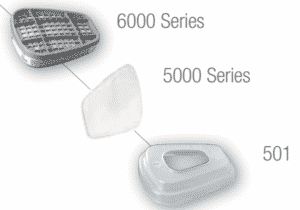
- A great half-mask (full face mask linked below)
- Over that, a good chemical cartridge*, (6000 series) or this one is also excellent. *
- Over that a filter to keep the dust out (5000 series) of your chemical cartridge (buy a box here)
- …and over that, a retaining clip ** (the 501) to hold on the dust filter (only need one for life). ***
- Sometimes I pop the above off and just use a Hepa filter all in one (not for bleach).****
- My old system was Honeywell, also very good: a mask without filters, and replacement Honeywell filters. Don’t get 3M filters.
* These filters are described in full on the 3M site if you are unsure that they filter what you want: the 6002 filter, and the 6003 filter. They eliminate VOCs, (read about VOCs in paint).
** Sometimes they sell out. If you cannot find a retaining clip, use tape!
*** These clips can be hard to find…and ignore the one-star rating. They work finel
**** Note that HEPA = “P100” = 100% of mold and dust and virus particles, the same or better than N95.
——-Notes——-
The filter for Croanavirus is “N95” (or P95, which is the same but also traps oils in the air). HEPA or P100 is even better.
The ‘exhaust’ of your breath is not filtered, so it would not be acceptable to prevent transmission to others of any flu or virus that you have.
If you’re unsure about the right filter for your toxin exposure, check the 3M chart linked here (pdf) and call your doctor. If exposure levels are not known, a fresh air tank system is recommended. Spend whatever it takes: the best respirator mask and chemical filters are a matter of life and death!
The chart at the very bottom to see what each cartridge filters: it’s complicated.
Care of the unit
Keep the opened filters in an air-tight container (like food) because they absorb toxins 24/7 which will shorten even the best respirator filter’s lifespan.
I use 2-3 layers of baggies for an air seal, plus a backpack for toughness.
Let the mask dry well before you wrap it up for next time (I put it on my hot water heater in the winter).
You can watch my video (also at the bottom of this article) to see how the system works together.
This is 30+ years of painting experience talking.
Viruses:
- These masks do not filter your out-breath.
- The EPA tells us here tells us to wear the “N95 mask”, the HEPA filter (P100), or the P95. “P” means that it also traps oils in the air, which the N95 does not. See the EPA’s chart here.
- Both P95 and N95 filter out at least 95% of very small (0.3 microns) particles which include all viruses and bacteria.
- For particulates only which include most viruses and MOLD, get the filter just for that, (contains 2 filters) and clips to the half-mask and full masks I recommend on this site.
- If unsure about the right filter for your toxin exposure, check the 3M chart linked here (pdf). If exposure levels are not known, a fresh air system is recommended.
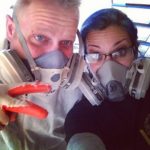
The cost?
Price? Shockingly low: very reasonable for what you get. The filters last and last if you care for them (see tips on care just above).
Spraying paint?
My system above is hands down the best respirator for spray painting with airless sprayers (read about sprayers). We always add the paper filter over it (see the kit linked above and combinations explained below). Some painters like the full face mask which also protects your eyes. Not me: I wear goggles.
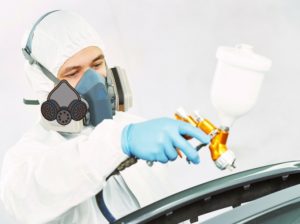
The best respirator for painting, in general, is the relatively low-cost mask and combination of excellent 3M filters shown above. Not just the best respirator for spray painting, but for brush / roll of all paints, even oils, epoxy, etc.
Note that 3M has a filter called “6200” and a mask called “6200”. Sad! But what we present all work with all the respirator masks shown on this page (except the disposable).
Sizes: S, M, L
- Small: 3M 6100 for smaller women
- Medium: 3M 6200 for many regular folks (the mask 6200, not the filter also called 6200!)
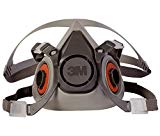
- Large: 3M 6300 (I use large & I’m 6’1″).
They are comfortable and well made and the strap system does not slip off (other makers do). The plastic halter fits any head. Remember, the paint respirator mask itself comes without any filters—see the bullet list below about buying the filters.
More filter types
Sometimes they sell out but these all work well. 3M respirator masks can be used with:
- A great chemical cartridge for many cancer-causing vapors—those nasty VOCs and more. This filter has a non-replaceable HEPA paper filter over the cartridge
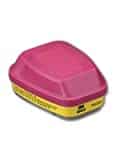 (cannot be removed). Don’t be fooled: the filter and mask have the same number!
(cannot be removed). Don’t be fooled: the filter and mask have the same number! - The “Multi-Gas/Vapor” filter, see the 60926 in the chart at the very bottom to see what it filters.
- Or use a stand-alone HEPA paper filter (the 3M “p-100” for pollen, sawdust, sanding paint etc).
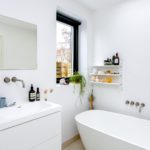
Gift of love:
This is my go-to gift: a high-quality respirator mask. I know it seems unusual, but I get good feedback.
Key point: use an outer particle filter to greatly lengthen the life of your (more expensive) chemical vapor filter to keep the viruses and dust. More below.

When to change filters?
You can tell when they need to be changed by your inhalations: the difference between the old one you are using contrasted with a new one.
Filter for bleach?
If you clean with bleach, I feel that it’s best to get the one that filters everything including bleach as bleach is really quite dangerous. We know a lifeguard that died from years of adding “chlorine” to the pool. Good to have it on hand. Also, you know, the coming Zombie Apocalypse. So, there’s that.
Disposable respirators?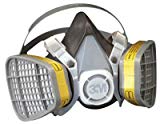
All right if you insist, but consider our mother earth too…
There is a very good 3M respirator mask (see it here) that comes with a vapor filter and promises 8 hours of heavy vapor filtering or 40 hours of light vapor filtering. But then you throw the whole thing away: seems a shame, but if you really are only going to do one job in your life, well, “you just have one job”.
The Full-Face Mask Respirator
See them described in this article. Complete protection.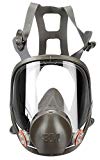
Protects face as well as lungs. Many people prefer this. Check the price here.
For spray painting, oil paints, for removal of asbestos, and so on. You can add any 3M filter you like as shown above. 3M recommends this for spray painting lacquer, enamel, and pesticides.
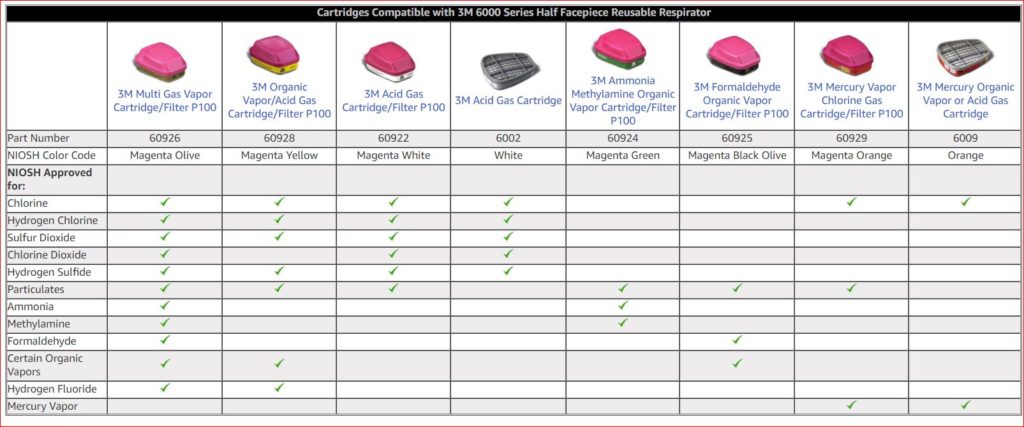
The information here is true to the best of my knowledge but is not a substitute for a doctor’s advice. If you suffer from allergies or may be exposed to a virus or bacteria, consult your doctor.
I’ve written about the dangers of VOCs and there is a lot on the internet if you need more, but the bottom line is: don’t risk your health breathing modern products: use a good respirator mask.
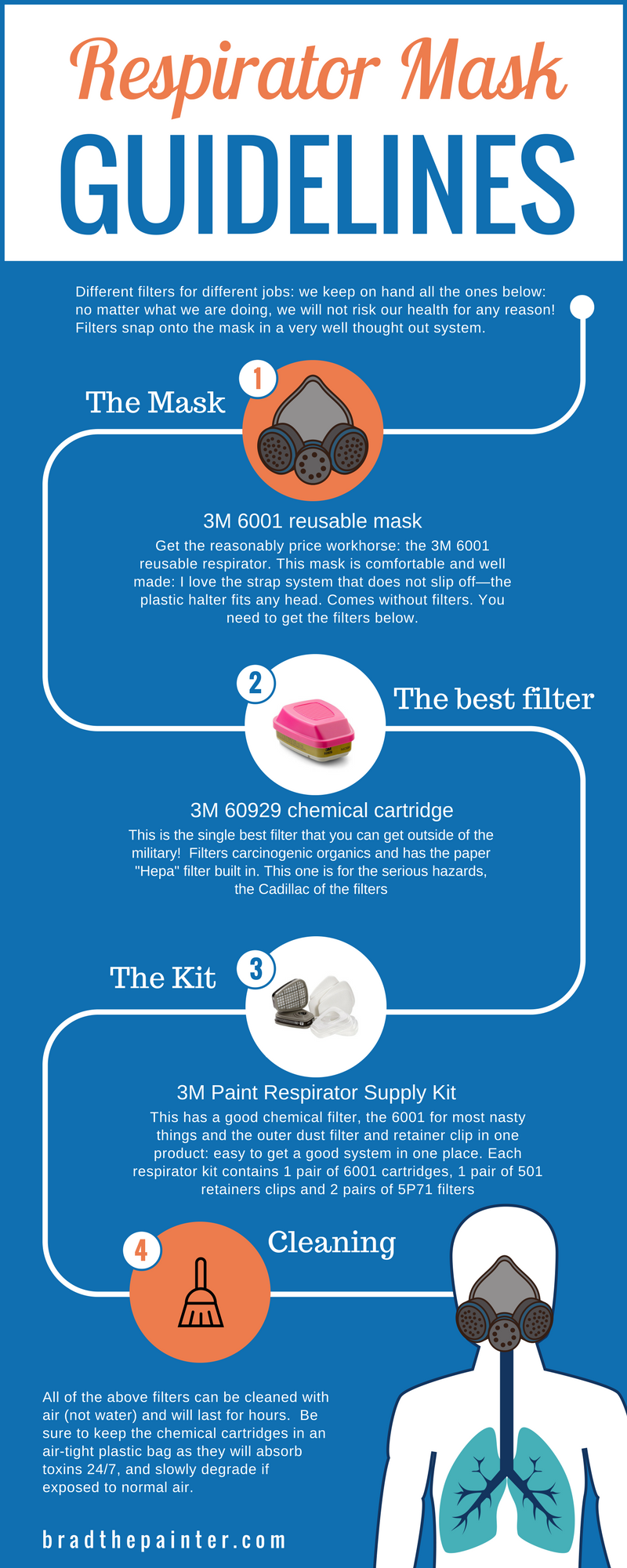
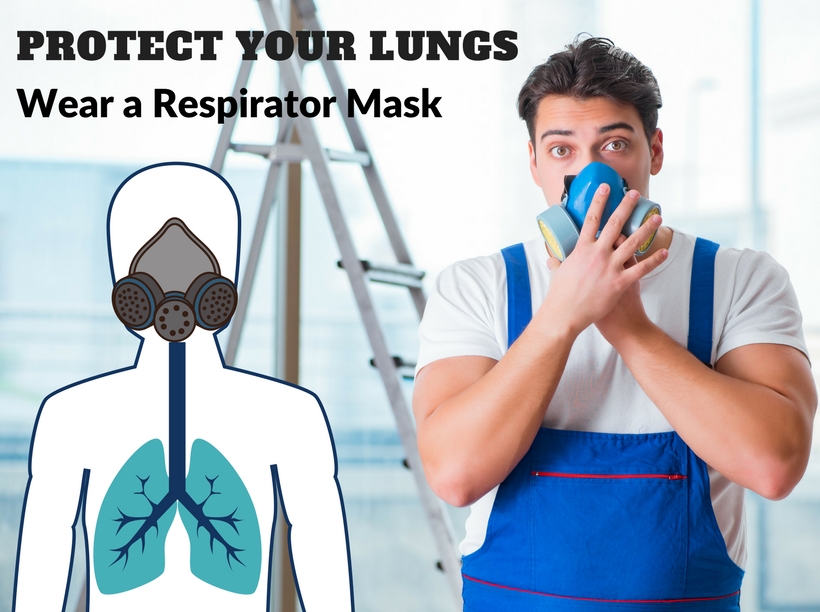
Hi Brad,
I’m considering painting a patio set that I think contains lead-based paint. Your article is great, but I’m still not sure what mask I should use to protect myself from lead.
Please contact a professional company. I’m afraid to answer that. I’d use the 3M full mask with the best filter, but that is just me. See the chart from 3M on all of what they filter: this is what I would do. But really call a pro anywhere in the country and ask for advice. Most folks will help and they will know better than me. In fact, I’d really advise a professional company test the old paint and remove it if you have the money.
I see that many masks like N95 or 3M mask are very hard to buy now.
Thanks so much for sharing such helpful article. Keep going.
Thank you for the very in-depth article!
Thanks
Sorry…Above, I meant the World Health Organization recommends the “N95” masks…whoops. My bad!
Holly
Hi Brad–What a beautifully designed and informative site! Thanks! I am a lone parent of a 12 year old and I look after two 86 year olds…so obv I am concerned during this viral outbreak. I have ordered and received the 6100 (small half face) for my daughter and the 6502QL (Rugged Comfort Quick Latch) for the rest of us. The only filters I was able to get are the pink round P100 2097s. Will these work as well as the World Health Org recommended P95 masks? I used to spray paint window display props, and had a half face for that…I bought the N95 vented masks, but they seem so flimsy and have an incomplete seal. I don’t want to depend on that, since I believe the benefit of the ones I got is in the seal. My child and I have non refundable plane tickets to FLA and I want to make sure I got the right round filters…Can you offer any advice? Thanks, Holly
Yes. If you read the US government docs, the 95 means about 95% of these particles are stopped in the filter. 100 as in the P100, aka HEPA, traps even more…about 99%.
You are so right about the flimsy masks. I just bought my wife a 6100 with many P95 filters.
I’m also in Fla regularaly.. a bit nervous!
I plan to wear my mask on the plane and in all crowds.
Good luck!
Hi . My wife gets headaches from strong smells . Planning on painting inside of home with oil paint for all woodwork and doors . Will these filters block smell
Yes when wearing the filters suitable for the toxin, there is NO smell. It’s pretty amazing. But how many hours can you wear it? Oil takes a long time to dry and then weeks to cure. You’ll have that ‘fresh paint smell’ for a while. Have a look at Advance I discussed here. It’s water-based alkyd. Before this new chemistry, (Ben Moore’s) alkyd was only oil based, Advance looks just like oil and comes in many sheens.
But if you stick with oil, ventilate well and seal off the areas you are working in from your wife’s nose!
Good luck.
Hi Brad. We are clearing out our parent’s home that has had water leaks and mold galore. Which respirators? Do we need eye protection? Do we need to were disposable suits? I’m almost 70 and don’t want any more health issues.
Thanks
Amy
Definitely protecty your lungs as well as your eyes. This is dangerous stuff. I had a friend who was also 70 and not protecting herself, she went to the hospital that day.
Think about a professional company: it would be worth the savings if the cost of doing it yourself is your health.
Also, if you can create a draft in one window and out the other, that will help. But it’s no excuse not to wear a respirator.
For this kind of work, get the full face mask with excellent filters. Buy some extra filters and change them each time it gets hard to draw air. They really last a long time though. After it arrives, you’ll have time to get the outer filters (HEPA that are like paper and stop most mold spores) and the inner more expensive cartridge for any organic vapors that go through the paper. This is a good system that keeps the expensive filters from getting clogged. This mask is good for using bleach as well as many kinds of paint, etc.
Good luck.
b